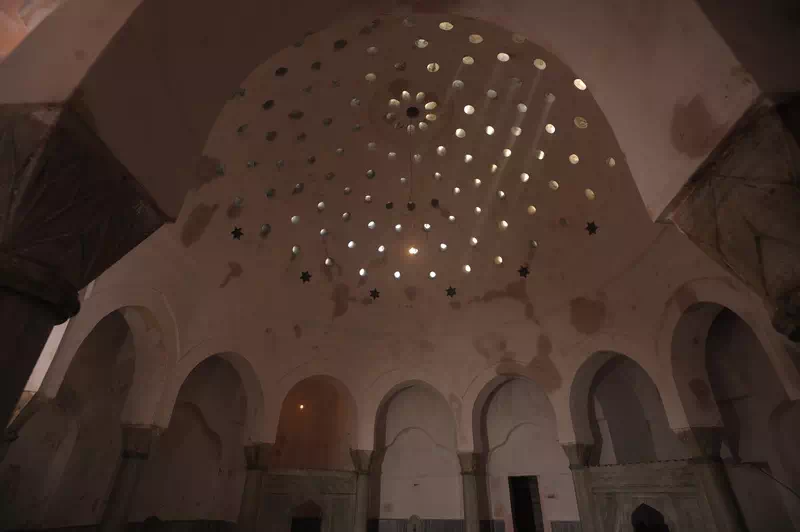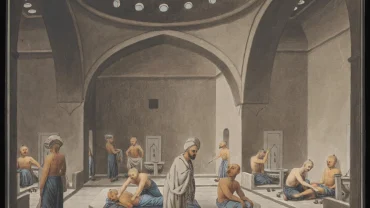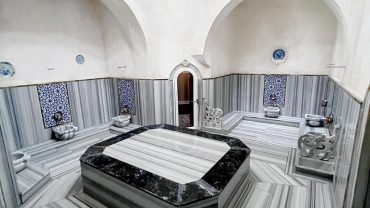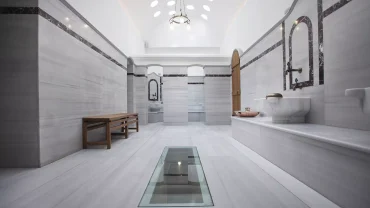Understanding Istanbul Hammam Architecture
Istanbul hammam architecture is an evolved form of ancient Roman and Byzantine bath structures, but the Ottomans brought a refined identity to the format. Each hammam follows a tripartite spatial layout designed to guide bathers through a gradual heating and cleansing ritual. These sections include:
- Camekan (cold room): A lounge space for relaxing and changing clothes, often decorated with ornate woodwork and a central fountain.
- Ilıklık (warm room): A space to acclimatize the body, prepare mentally and physically for the next phase.
- Hararet (hot room): The heart of the hammam where the cleansing takes place. Dominated by the central göbek taşı (heated marble platform), this room is where most of the ritual occurs.
Materials such as marble and local stone provide excellent heat retention and moisture control. The domes above the hot rooms are perforated with small glass pieces, known as “elephant eyes,” that allow light to pass through like stars, creating a dreamlike ambiance.

Historical Hammam Design and Ottoman Philosophy
Historical hammam design was more than engineering; it was a philosophical and spiritual manifestation. Great architects like Mimar Sinan embedded principles of sacred geometry into their blueprints, believing that symmetry and balance reflected cosmic harmony. Spaces were not just meant for washing the body but for purifying the soul.
Ottoman hammams were frequently built as vakıf (charitable endowments), often alongside mosques, schools, and soup kitchens. This integration reflected the holistic Islamic vision of well-being that encompassed both body and spirit.
Ottoman Hammam Buildings: Icons of Civic Pride
Ottoman hammam buildings served as more than hygiene centers. They were gathering spots, negotiation venues, matchmaking locations, and even venues for pre-wedding ceremonies. Their exteriors were often simple, but their interiors exuded wealth and refinement.
Noteworthy Examples Include:
- Hürrem Sultan Hammam: Commissioned by Roxelana, the powerful wife of Sultan Suleiman, and designed by Mimar Sinan. A symbol of female patronage.
- Kılıç Ali Paşa Hammam: Built for Ottoman navy commander Kılıç Ali Paşa, showing maritime motifs and sophisticated domes.
- Çemberlitaş Hammam: One of the last major hammams of the classical Ottoman period, showcasing minimalistic elegance.
The walls of these structures are often covered in poetic inscriptions, Quranic verses, and floral motifs, blending architecture with literature and faith.
Key Turkish Bath Architectural Elements
The core Turkish bath architectural elements include more than walls and ceilings. They engage the five senses:
- Domes: Symbolize the celestial world and help circulate heat efficiently.
- Kurna: Individual basins where bathers scoop water to wash themselves. Made of carved marble and often artistically designed.
- Göbek taşı: The heated platform where the main washing rituals take place, often placed directly beneath the dome.
- Halvet: Small, private chambers around the hararet room, used for individual bathing.
The acoustics in hammams were carefully considered. Sounds of flowing water and echoing voices added a meditative rhythm to the space. Iznik tiles with cobalt blues and floral designs were commonly used for decoration, providing a cooling psychological effect.

Famous Hammams in Istanbul
Several famous hammams in Istanbul still function as both tourist attractions and traditional bathhouses. They include:
- Galatasaray Hammam: Built in 1481 and still located in the bustling Beyoğlu district, it maintains its classical features.
- Cagaloglu Hammam: Built in 1741 and one of the last examples of monumental hammam construction in the Ottoman Empire.
- Süleymaniye Hammam: Located near the grand mosque complex of Sultan Süleyman, this hammam has a direct lineage to the golden age of Ottoman architecture.
These places are not only historically important but also provide insight into how traditional Turkish bath architecture is preserved and adapted in modern times.
Reviving Traditional Turkish Bath Architecture Today
Modern spa culture is rediscovering the value of traditional Turkish bath architecture. Luxury hotels and boutique wellness centers across the world are emulating the serene ambiance and therapeutic design of Ottoman hammams. Elements like heated marble slabs, domed ceilings, and water rituals are being integrated into contemporary architecture.
This revival proves that the philosophy of the hammam—centered on cleanliness, reflection, and community—is timeless and adaptable to modern wellness needs.
Conclusion: A Living Cultural Legacy
The architecture of Istanbul’s historic hammams is a treasure trove of cultural, artistic, and spiritual heritage. From the flowing curves of its domes to the warmth of its marble, the hammam is both a sanctuary and a symbol. As Istanbul modernizes, preserving these landmarks is vital—not just for tourism or aesthetics but as active conduits of Ottoman wisdom and Turkish identity. Whether you’re stepping into a centuries-old bath or visiting a modern interpretation, you’re participating in a ritual that transcends time.





Comment (0)